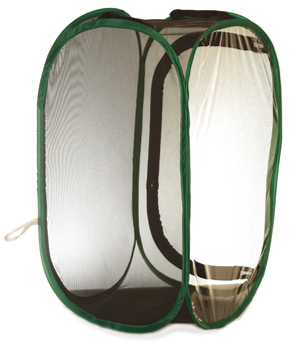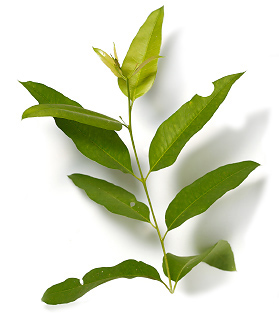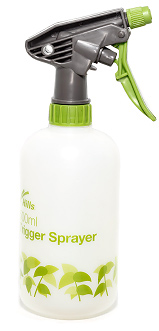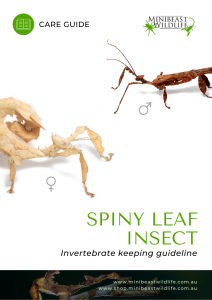BUG KEEPING TIPS
STICK INSECTS
Keeping stick and leaf insects is very easy and fun. Minibeast Wildlife has has everything you need!
Keeping stick and leaf insects is very easy and fun. Minibeast Wildlife has has everything you need!
Stick and leaf insects (known as phasmids) are herbivorous insects and are masters of camouflage. Australia has over 100 species of these amazing animals, which have evolved into a great range of forms. Some are long and twig like, some knobbly and others look just like leaves. A number of these insects are now available as pets.
Phasmids require the following basic things in captivity :
Keeping stick and leaf insects is quite easy to do, but there are some basic things that are important to keep them happy and healthy. Most of the tasks involved in keeping stick insects are relatively simple and take very little time, but like with any pet, ensuring you do the basics well is the key to having a healthy live animal.
Food:
Stick and leaf insects feed on live plants in the wild, and live on the branches and leaves they feed on. In captivity they require fresh foliage. The easiest way to do this is by providing it in the form of a small branch in the insect’s enclosure. Keep the stem in a small vase/jar of water – just as you would to keep flowers fresh. It’s best to cover the top of your water container with something (eg foil) to prevent the stick insect drowning just in case it falls in.
Ensure you have the appropriate leaves for the species of stick insect you are keeping. Many species will eat gum leaves, but some species are very fussy about what they eat and require specific types of plants. This is an important consideration when choosing the type of stick or leaf insect you want. Minibeast Wildlife has free Care Guides for all the species of stick insects we sell – make sure you read the guide to find out what type of leaves you need. This information is also on each of the species pages in the Minibeast Wildlife’s Bugshop.
Ensuring the food plant is fresh is really important. The leaves must be changed if they begin to dry out or wilt. Many plants will last for several days at least with the stem in water, but it depends on the temperature, airflow and the humidity in the room they are being kept in. Air conditioning and gas heating will often dry the air and accelerate the rate at which plants will dry out. Check the food plant each day and replace it when required.
An important tip is to make sure your little branch of leaves is tall enough to touch the top of the enclosure’s ceiling. Stick and leaf insects naturally like to climb upwards to find fresh food. If the food plant doesn’t reach the ceiling of the enclosure, the insects may climb the walls and wander the ceiling looking for food and not find it. Most don’t have the instinct to come back down, so they can starve as a result. They aren’t silly – it’s just their natural instincts that have evolved to help them survive in the wild.
Water:
Stick and leaf insects get water from the leaves they eat (which is why it is important to keep them fresh). They get additional water from dew drops and rain on the plants they live on in the wild. Since the air inside our houses is often dryer than the air outside, it is important to offer them some water each day to prevent dehydration. This is very simple – just lightly mist spray the leaves, enclosure walls and the insects each day. If your stick insect is thirsty you will see it drinking the droplets off the various surfaces.
Handling:
Stick and leaf insects are harmless insects and are safe to handle, however you should be mindful that too much handling can be detrimental to their health. We recommend handling be limited to around 15 minutes per day. (In the wild, these insects spend most of their time sitting quite still doing very little – otherwise they blow their camouflage!)
Moulting:
Stick and leaf insects have exoskeletons – a skeleton on the outside of their bodies and don’t have a spine or internal bones. To grow they need to periodically shed their old exoskeleton and emerge larger with a brand new one. a process known as moulting. Prior to this the insects usually hang upside down in one spot for a prolonged period, often not eating. Their posture is often a little unusual and somewhat rigid. Moulting often happens at night, and the insects should not be disturbed during it. Once it begins, they usually will complete the moult within 15 minutes or so, and then will hang nearby as their new exoskeleton hardens. They will often eat their old exoskeleton afterwards. This is a fascinating process to watch, but is a critical time for them as they are vulnerable and any physical interruption can result in them becoming stuck in the old exoskeleton and losing limbs or even dying. Once stick and leaf insects reach maturity (when they have wings) they do not moult any more.

Mesh enclosures are ideal for phasmids as they provide good ventilation and surfaces that they can climb easily.

Fresh leaves need to be available for phasmids to feed on at all times. Many species will feed upon gum leaves, while some are more specialised requiring particular species of plants. Learn more in our Care Guides.

Misting bottles are the best way to provide water for captive phasmids – in the wild they drink rain and dew drops.

Minibeast Wildlife’s Care Guides cover all the basic information you need to keep pet stick insects. We have Care Guides for every species we breed and sell.
Whether you're just beginning or a seasoned keeper, this book offers great advice to improve your skills and aids you to keep your bugs alive and healthy. It covers everything you could ever want to know about keeping more than 90 species of Australia’s most fascinating terrestrial invertebrates, including many phasmids! Its also includes four detailed chapters on housing, diets, health and creating bug displays.